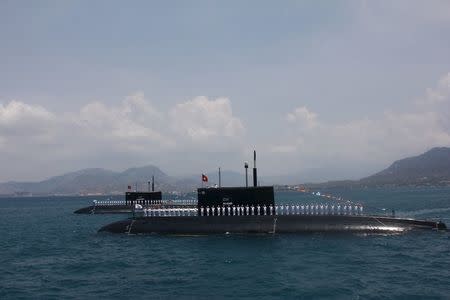Factbox: Inside Vietnam's military modernisation

By Greg Torode HONG KONG (Reuters) - Vietnam has embarked on its biggest military build-up in decades in an attempt to deter a rising China. Hanoi's battle-hardened military atrophied after the Vietnam War amid broader economic woes and the collapse of its Cold War patron, the Soviet Union. Following are key purchases and plans according to Reuters reporting, the Stockholm International Peace Research Institute, the International Institute of Strategic Studies and Vietnamese state media: NAVY Vietnamese crews, supported by Russian advisors, operate four Russian-made, Kilo-class submarines from a purpose-built base in Cam Ranh Bay in south-central Vietnam. Another two submarines are expected to arrive in 2016 and the entire fleet is expected to be fully operational by 2017. The Vietnamese 636.3MV Kilos are equipped with both anti-ship and land attack variants of the Klub cruise missile, heavy torpedoes and mines. Vietnam is also acquiring Russian-designed ships equipped with anti-ship missiles and other weapons. The fleet currently includes 2 Gepard frigates, 6 corvettes and 18 fast-attack missile boats. New vessels will have enhanced anti-submarine weapons. Less visibly, Vietnam has strengthened its coastal defences with anti-ship artillery batteries and the mobile Bastion K-300P system, equipped with Orynx cruise missiles. The Orynx can also be fired from ships, planes and submarines. Foreign security experts say Vietnam has made it potentially costly for China's navy to operate within 200-300 nautical miles of its coast - an ability it did not have a decade ago. This may be further boosted by a future deal to buy the Indian-Russian produced BrahMos missile, a supersonic anti-ship weapon that is the world's fastest cruise missile. Chinese analysts say Beijing's reclaimed islands in the South China Sea will give it extra protection against Vietnam's strength from its southern coast. AIR FORCE Vietnam operates an expanding fleet of 30 Russian-supplied Su-30 MK2 fighter-bombers, which patrols its military bases over the Spratlys. Hanoi also has older squadrons of Su-27s and even older Russian craft. Though far outnumbered by China's air force, which includes similar planes, Hanoi's military chiefs have upgraded and expanded air defences. It has obtained Israeli AD-STAR 2888 early warning radars and Russian-built S-300 surface-to-air missile batteries. Vietnam had extensive experience in using earlier Russian-built systems to shoot down U.S. jet fighters and B-52 bombers over northern Vietnam during the Vietnam War. Hanoi is also in talks with European and U.S. arms manufacturers to buy additional fighter jets, maritime patrol planes and unarmed surveillance drones. ARMY Vietnam maintains a conscript-based force of an estimated 450,000 troops. It has recently started manufacturing Israeli rifles under license, and also used Israeli and European technological help to refit up to 850 Russian T-59 and T-55 tanks. Parliament this year passed laws lengthening compulsory military service from 18 months to two years, as well as extending deferments to allow more university students to serve after completing their studies. (Additional reporting by Ho Binh Minh. Editing by Dean Yates and Bill Tarrant)

